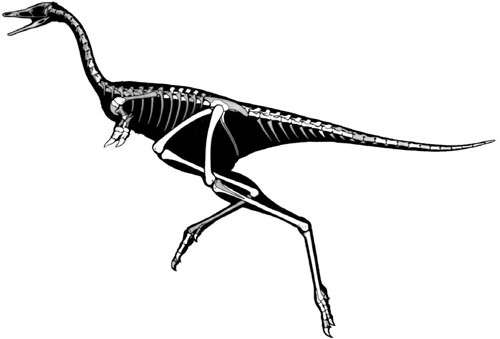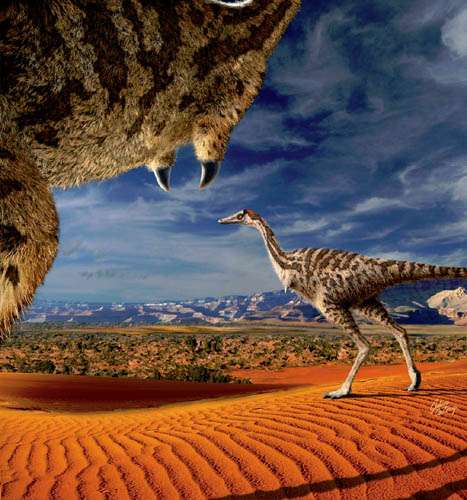Fig.1 Alvarezsauroid theropod Linhenykus monodactylus. Skeletal silhouette showing preserved bones (missing portions shown in grey). (Image by XU Xing)
The alvarezsauroid theropod Linhenykus monodactylus from the Upper Cretaceous of Inner Mongolia, China is the first known monodactyl non−avian dinosaur, providing important information on the complex patterns of manual evolution seen in alvarezsauroids. In a paper published in the journal of Acta Palaeontologica Polonica 58 (1), Dr. XU Xing, Institute of Vertebrate Paleontology and Paleoanthropology (IVPP), Chinese Academy of Sciences, and his team provide a detailed description of the osteology of this taxon. Linhenykus shows a number of features that are transitional between parvicursorine and non−parvicursorine alvarezsauroids, but detailed comparisons also reveal that some characters had a more complex distribution.
With only one exception, all known alvarezsauroid theropods are restricted to Upper Cretaceous deposits. Among these Late Cretaceous alvarezsauroids, Asian species possess the most specialized body−plans, and are best known from the Upper Cretaceous of Mongolia. The Mongolian alvarezsauroid assemblage includes taxa, such as Mononykus olecranus from the Nemegt Formation and Shuvuuia deserti from the Djadokhta Formation, whose systematic positions have been highly debated. Djadokhta−equivalent deposits in the neighboring Chinese region of Inner Mongolia contain a broadly similar vertebrate fauna, but few alvarezsauroid specimens have been recovered from Inner Mongolia.
In the 2008 summer field season, a joint expedition team from the Institute of Vertebrate Paleontology and Paleoanthropology, the Longhao Institute of Geology and Paleontology, and the Bureau of Land and Resources of Bayannur, Inner Mongolia prospected in the Upper Cretaceous dinosaur−bearing deposits of the Bayan Mandahu area in north-central Inner Mongolia, and collected some small theropod bones in the red beds at the Gate Locality. Later on, more elements belonging to the same specimen were found nearby. The preservation and distribution of the bones suggest that the specimen was originally preserved in a concretion that had fully weathered out on the surface of the outwash plain.
The presence of a robust medial manual digit and a fused, block−like carpometacarpus identify this specimen as an alvarezsaurid theropod, but several features distinguish it from other known alvarezsaurids. It was reported as a new species, Linhenykus monodactylus, and a phylogenetic analysis placed it at the base of the derived clade Parvicursorinae in 2011. Furthermore, only one metacarpal of this specimen possesses manual phalanges, indicating that this animal has only one phalanx−bearing digit and thus represents the first known monodactyl non−avian dinosaur.
Fig.2 Life reconstruction of two individuals of Linhenykus monodactylus. Credit: Julius T. Csotonyi
The highly modified hindlimbs of parvicursorines have been interpreted as an adaptation for rapid running. One commonly used indicator of cursoriality is the length of the crural segment of the hindlimb relative to that of the femoral segment, though this is probably more effective in promoting energy efficiency during running than in permitting a high maximum speed. Previous analyses have shown that derived theropods possess relatively greater tibia/femur length ratios than primitive ones, and this evolutionary trend continues into the Aves. However, many theropod groups display an opposite trend during their evolutionary history.
Alvarezsauroidea and Aves are exceptional among the major theropod groups in elongating the crural segment of the hindlimb in their evolutionary history, which is probably related to a size−decrease trend within these two groups. Linhenykus has a tibia/femur length ratio of about 1.40, similar to other parvicursorines but significantly greater than in basal alvarezsauroids and most other non−avian theropods. In derived alvarezsauroids, pronounced elongation of the tibiotarsus relative to the femur is more likely to indicate increased cursorial capability. Given that parvicursorines have higher tibia/femur ratios than most other non−avian theropods, they are probably among the most capable cursors within this evolutionary grade. Further indicators of cursorial specialization include the extremely elongate metatarsus (longer than the femur), specialized arctometatarsalian pes, and proportionally short and robust pedal phalanges of alvarezsaurids.
Researchers use event−based tree−fitting to perform a quantitative analysis of alvarezsauroid biogeography incorporating several recently discovered taxa. The results suggest that there is no statistical support for previous biogeographic hypotheses that favour pure vicariance or pure dispersal scenarios as explanations for the distributions of alvarezsauroids across South America, North America and Asia. Instead, statistically significant biogeographic reconstructions suggest a dominant role for sympatric (or "within area") events, combined with a mix of vicariance, dispersal and regional extinction.
"Our results suggest that the biogeographic history of alvarezsaurids is likely to be somewhat more complex than previously realized. At present the alvarezsauroid data set is too small to completely resolve the biogeographic history of this group. Future studies will need to create larger data sets that encompass additional clades", said XU Xing, lead author of the study.
More information: dx.doi.org/10.4202/app.2011.0083
Journal information: Acta Palaeontologica Polonica

























